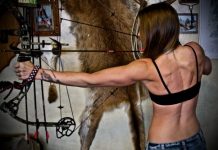Training your Pup to Shed hunt
Shed hunting has become a sport in itself, while in the not so distant past it was a way to stay connected to hunting in the off-season. Now, people from all over the world come to take part in shed hunting. Fueled by the growing market for selling shed antlers, this tool for finding big bucks and bulls has become an industry of its own. In this highly competitive niche everyone is looking for an edge, from trying to keep wintering animals on their property to contraptions to help sheds fall off where they want them. Additionally, many people, myself included, have trained dogs to find sheds.
Starting them young
One of the first steps to training your dog for anything is to get them used to the idea that when they do what you ask them they get rewarded. One of the things I do from the get-go with my pups is make them wait when I feed them. Most people pour the food into the bowl and their dogs are already at the bowl chopping away before you are even done pouring. I make my dogs sit and wait while I pour and then wait even longer till I give them the OK to eat. This does a few things for you and your dog: 1) stops them from trampling all over you while you are trying to feed them, 2) Establishes your dominance, and 3) instills a reward system.
Obviously we can write a whole book on dog training and there is a lot more to having a good shed dog than just techniques in getting them to find and retrieve sheds. You must also learn how to control your dog; obedience training is the pillar in any sport-specific training for dogs. A good shed dog has a love for the hunt, is obedient, and has a good nose. However, for the purposes of this article we will only discuss techniques for shed retrieval.
Step #1
Start your pups out by playing fetch with rubber dummy antlers laced with antler scent. Have the pup sit by your side, show him the antler, have him smell it, and then toss it out a few feet. More than likely he/she will instinctively run and smell it and maybe mouth it or chew it. But the idea is to coax them to bring it back to you. Don’t go get it from them, rather just keep trying to get them to bring it to you and when they do reward them with a treat and affection.
Slowly start integrating obedience by having them sit/stay until you give them the command to fetch and eventually only play fetch by making them sit/stay or fetch on command. Once your dog has mastered fetch on command start making them sit/stay and instead of you throwing the antler go place it out a few feet in front of your dog, slowly walk back, and then command them to fetch. Always use the same word or phrase so they can associate “go get the antler and bring it to me” while training.
Note: Never allow your dog to chew on antlers or anything resembling an antler. That’s what chew toys are for. You don’t want your dogs to find a beautiful brown out in the field and run off under a tree to chew on it.
Step #2
Once your pup has mastered “retrieve on command,” start placing the antler out of sight when you play your “retrieve on command” game, progressively making it more and more challenging to find the antler. Also, start placing the antler in other rooms and once you give your pup the command to go get it, move the antler to another room forcing him/her to find you.
Next, you can start bringing it outside. The game I play with my pup outside is to lock him in the house, hide the antler outside, and after I open the door for him to find it I go back inside the house and wait for him to find me. Always remember that repetition is key and reset the sequence, that way he knows that his job isn’t done after he finds the antler. A good example of this is shown in this video. At this time I introduce the backpack as well, alternating antlers from my backpack.
Also, I introduce a training collar and whistle at this stage. Using the same principles identified above I begin making my dog sit/stay, I walk 20-50 yards away, then I call them with the vibration, whistle and hand motion all at the same time and give them a treat when they come. I keep practicing this while leaving some parts out. Eventually I move out of sight and just use the whistle or just the vibration mode of the collar to call them. This helps you keep control of the dog while out in the field and when he/she is out of sight. Also, your dog will recognize every time you put the collar on that it’s time to work.
Note: During this stage if your dog has completed teething than you can begin introducing real antlers, but keep them small at first and progress to larger ones.
Step #3
If your dog has mastered finding antlers in the yard by alternating antlers from your pack, you are ready to start multiple antler retrieval. This game is the same but now you hide 3 antlers instead of 1, and when your dog comes back with the first you reward him, reset him with the sequence you have implanted, and send him/her back out until they bring back all 3. Always be sure that he/she sees you put the antler in your pack before you send them out for another antler, that way your dog is not tracking you down. Another good practice is to call them back when they lose focus to reset them. Also, depending on their age when they get into stuff that is not favorable, or chase game that is not favorable, I introduce negative feedback with the E-collar. Yes I zap them!
Note: This is also a good time to have your dog Snake trained. Snake avoidance is key since shed hunting is often done in spring and snakes can emerge at that time.
Step #4
It’s time to start expanding the playing field and being creative with your hiding spots. Start bringing your dog to other controlled environments outside their normal daily life and use multiple antlers. Dogs will start to remember your hiding spots and will remember the specific smell of “his/her” antlers. Be sure not to set your dogs up for failure because they may lose interest and you may have a dog that will quit on you prematurely out in the field.
The last piece of the puzzle is working with them and giving them your parameters. This all depends on how you like to operate in the field. I prefer to keep my dogs on a shorter “leash” as I hike. I limit their range to about 50-60 yard circles. Basically, as I hike my dogs will run circular patterns around me 50-60 yards, but some of you may just want to send them out into a field or stay by your side, its all preference. You achieve these limits by using the E-collar and whistle.
Note: It is important to continually wash the antler after use to keep the smells natural.
Your dog is almost ready. Like all training, naturally progress them to your end goal, taking them to the next level after they mastered the last. Keep it fun and he/she will live for the hunt.














